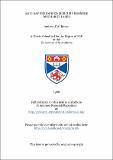An X-ray preionised mercury bromide discharge laser
Abstract
An X-ray preionised mercury bromide discharge laser (502-504 nm) has been designed, constructed and optimised. The double pulse forming line system built to drive the laser has proven to be both versatile and reliable. It utilises multiple-paralleled thyratrons and has demonstrated the characteristics required for long life operation of high average power gas discharge lasers. The supply produces a voltage pulse of 240 nsec duration and its output impedance is variable from 300 mO to 3.6O. With twelve thyratrons in parallel current risetimes of 83 kA musec-1 into a 300 mO matched load and 2 nsec jitter have been achieved. A voltage transient on the leading edge of the discharge pulse, to aid gas breakdown, up to 1½ times the line charge voltage is possible through a 'spike line' incorporated in the system. The X-ray preioniser, based on a cold cathode field emitter, produces an exposure of 5 mR in the discharge region which is adequate for effective preionisation of the laser. A full parametric study of the laser covering gas composition and pressure. X-ray source effects energy loading and other pulsed power supply effects has been carried out. The peak output energy recorded was 710 mJ with neon buffer gas at 4 atmospheres pressure. This represents an energy extraction of 0.5 JL-1. Pulse lengths of 92 nsec (FWHM) and efficiencies greater than 1.5 % have been achieved.
Type
Thesis, PhD Doctor of Philosophy
Collections
Items in the St Andrews Research Repository are protected by copyright, with all rights reserved, unless otherwise indicated.

